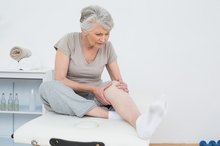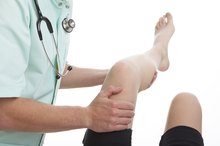Causes of Pain in the Hip and Groin Area
**Hip and groin pain can turn even a highly active person into a couch potato in a hurry.
If you are experiencing serious medical symptoms, seek emergency treatment immediately.
Many conditions cause pain in the frontal hip and groin area, referred to medically as anterior hip pain. Pain in this area occurs in people of all ages and activity levels. ** Anterior hip pain can develop suddenly, typically due to an injury, or evolve more gradually. Abnormalities of the hip joint and supporting structures account for most cases of anterior hip pain.
Strains and Tendon Disorders
Strains and tendon disorders commonly cause anterior hip pain among elite and recreational athletes, especially those who participate in sports that involve sprinting, rapid pivoting and kicking. A strain -- tearing of muscle or tendon fibers -- usually occurs suddenly, or acutely. Tendinopathy describes a tendon abnormality, including tendinitis and tendinosis. Tendinitis refers to acute inflammation of a tendon, while tendinosis describes tendon degradation due to chronic overuse. Several muscles and tendons converge at the anterior hip, including the iliopsoas, rectus femoris, hip adductors and rectus abdominus.
A strain injury involving one or more of these muscles usually causes sudden anterior hip pain. With tendinosis, pain typically evolves more gradually or intermittently, and worsens with continued activity.
- Strains and tendon disorders commonly cause anterior hip pain among elite and recreational athletes, especially those who participate in sports that involve sprinting, rapid pivoting and kicking.
- Tendinitis refers to acute inflammation of a tendon, while tendinosis describes tendon degradation due to chronic overuse.
Hip Arthritis
Causes of Pain in the Buttock Area
Learn More
Hip arthritis is a common culprit for frontal hip and groin pain. Many types of arthritis can affect the hip, all of which share in common joint inflammation and pain 5. Osteoarthritis is the most common arthritic disorder affecting the hip 5. It is most frequently diagnosed in people older than age 50, but can develop earlier -- particularly if there has been a previous hip injury. Rheumatoid arthritis (RA) can also affect the hips 5. **Although it can occur at any age, RA most often begins in people aged 30 to 60.
** Other types of arthritis that can affect the hips including psoriatic and infectious arthritis, among others 5. Systemic inflammatory conditions, such as lupus and polymyalgia rheumatica, might also cause hip inflammation and anterior hip pain.
- Hip arthritis is a common culprit for frontal hip and groin pain.
- Other types of arthritis that can affect the hips including psoriatic and infectious arthritis, among others 5.
Bone and Cartilage Disorders
The hip joint is formed by the rounded head of the thighbone, or femoral head, and a cup at the side of the pelvis called the acetabulum. Both surfaces are cushioned with cartilage to reduce friction and prevent rubbing between the bones. Hip bone or cartilage problems typically cause anterior hip pain. Fractures of the femoral neck, located just below the femoral head, are an example. Traumatic fractures are usually obvious. Tiny breaks called stress fractures are more subtle, and represent an overuse injury, which most often occurs in runners.
**A condition called avascular necrosis of the femoral head is another possible culprit for anterior hip pain.
** With this condition, the femoral head slowly dies due to insufficient blood supply. Risk factors include previous trauma to the bone and long-term use of oral steroids.
Other bone and cartilage disorders that frequently cause anterior hip pain include: -- labral tear: tearing of the ring of cartilage surrounding the acetabulum -- chondral damage: damage to cartilage covering the femoral head or lining the acetabulum -- femoroacetabular impingement: bone spurs of the hip
- The hip joint is formed by the rounded head of the thighbone, or femoral head, and a cup at the side of the pelvis called the acetabulum.
- A condition called avascular necrosis of the femoral head is another possible culprit for anterior hip pain.
Nerve Disorders
Lower Stomach & Groin Pain
Learn More
Compression of nerves in the hip region are another possible cause of anterior hip pain.
Obturator nerve entrapment often causes pain in this area accompanied by numbness, burning or tingling of the upper inner thigh. The obturator nerve courses through the pelvis and innervates several thigh muscles. Pain and other symptoms typically occur or worsen with certain leg movements, including hip extension and adduction, or pulling the upper leg inward. Hip adductor muscles often show reduced strength on the affected side.
Ilioinguinal nerve entrapment is another nerve compression syndrome that can cause anterior hip pain. Typical symptoms include burning pain at the front of the hip, which commonly radiates to the scrotum or labia, and upper inner thigh. Because the ilioinguinal nerve courses through the abdominal wall, leaning forward often relieves pressure on the nerve and reduces discomfort.
Left untreated, this condition might also cause weakness and bulging of the lower abdominal wall on the affected side. A bulging or herniated disc in the lower spine -- the lumbar spine -- can also sometimes cause referred pain in the hip and groin area.
- Compression of nerves in the hip region are another possible cause of anterior hip pain.
- Ilioinguinal nerve entrapment is another nerve compression syndrome that can cause anterior hip pain.
Bursitis and Other Causes
Other orthopedic and medical conditions can cause anterior hip pain. A bursa is a fluid-filled sac located between bones and muscles or tendons that reduces friction during movement.
Inflammation of the iliopsoas bursa, located at the front of the hip, can lead to anterior hip pain that typically occurs or worsens with activity -- especially extending the leg backward from the hip. Iliopsoas bursitis often produces a lump in the groin area 8.
Two other conditions called athletic pubalgia and groin disruption are also considerations, although the pain is typically limited only to the groin with both ailments. These conditions occur due to weakening of the interior abdominal wall in the groin area and typically cause gradually worsening groin pain.
Importantly, a number of medical disorders that do not involve the musculoskeletal system can cause frontal hip, groin and lower abdominal pain -- usually accompanied by other signs and symptoms.
These include abdominal and pelvic tumors, and a wide variety of digestive, urinary and reproductive system disorders. Importantly, physical activity is usually unrelated to the pain caused by these conditions.
- Other orthopedic and medical conditions can cause anterior hip pain.
- Importantly, a number of medical disorders that do not involve the musculoskeletal system can cause frontal hip, groin and lower abdominal pain -- usually accompanied by other signs and symptoms.
Regardless of your age or activity level, do not to ignore pain in the hip and groin area. This discomfort could limit your activity, potentially compromising your long-term health, and might indicate a serious medical problem.
See your doctor as soon as possible if you experience pain in your hip and groin area. Seek immediate medical care if your pain is related to an accident or traumatic injury, is severe or getting worse, or is accompanied by any warning signs and symptoms, including: -- inability to move your leg normally -- sudden leg numbness, weakness or paralysis -- rapidly developing testicular or scrotal swelling -- unexpected vaginal bleeding, especially if you might be pregnant -- fever, chills or clammy skin -- nausea, vomiting or bloody or black stools -- dizziness, lightheadedness or fainting
Reviewed and revised by: Tina M. St. John, M.D.
- Regardless of your age or activity level, do not to ignore pain in the hip and groin area.
Related Articles
References
- Musculoskeletal Diseases 2009-2012: Diagnostic Imaging; Jurg Hodler, et al.
- American Family Physician: Anterior Hip Pain
- American Family Physician: Evaluation of the Patient with Hip Pain
- The Journal of Family Practice: Evaluation and Management of Hip Pain: An Algorithmic Approach
- Arthritis Foundation: Arthritis and Diseases That Affect the Hip
- Current Reviews in Musculoskeletal Medicine: Obturator Neuropathy
- Physical Diagnosis of Pain: An Atlas of Signs and Symptoms; 3rd Edition; Steven D. Waldman
- Rheumatology Network: Iliopsoas Bursitis
- American Academy of Orthopedic Surgeons. (n.d.). Hip Fractures. https://orthoinfo.aaos.org/en/diseases--conditions/hip-fractures/
- Shetty VD, Shetty NS, Shetty AP. Groin pain in athletes: a novel diagnostic approach. SICOT J. 2015;1:16. doi:10.1051/sicotj/2015017
- Tyler TF, Silvers HJ, Gerhardt MB, Nicholas SJ. Groin injuries in sports medicine. Sports Health. 2010;2(3):231-6. doi:10.1177/1941738110366820
- Jenkins JT, O'dwyer PJ. Inguinal hernias. BMJ. 2008;336(7638):269-72. doi:10.1136/bmj.39450.428275.AD
- Chung C, Stern PJ, Dufton J. Urolithiasis presenting as right flank pain: a case report. J Can Chiropr Assoc. 2013;57(1):69-75.
- Khan AM, Mcloughlin E, Giannakas K, Hutchinson C, Andrew JG. Hip osteoarthritis: where is the pain? Ann R Coll Surg Engl. 2004;86(2):119-21. doi:10.1308/003588404322827518
- Pun S, Kumar D, Lane NE. Femoroacetabular impingement. Arthritis Rheumatol. 2015;67(1):17-27. doi:10.1002/art.38887
- Groh MM, Herrera J. A comprehensive review of hip labral tears. Curr Rev Musculoskelet Med. 2009;2(2):105-17. doi:10.1007/s12178-009-9052-9
- Moya-angeler J, Gianakos AL, Villa JC, Ni A, Lane JM. Current concepts on osteonecrosis of the femoral head.World J Orthop. 2015;6(8):590-601. doi:10.5312/wjo.v6.i8.590
- Larson CM. Sports hernia/athletic pubalgia: evaluation and management. Sports Health. 2014;6(2):139-44. doi:10.1177/1941738114523557
- Allegri M, Montella S, Salici F, et al. Mechanisms of low back pain: a guide for diagnosis and therapy. F1000Res. 2016;5. doi:10.12688/f1000research.8105.2
- Gomella P, Mufarrij P. Osteitis pubis: A rare cause of suprapubic pain. Rev Urol. 2017;19(3):156-163.
- Bisciotti GN, Auci A, Di marzo F, et al. Groin pain syndrome: an association of different pathologies and a case presentation. Muscles Ligaments Tendons J. 2015;5(3):214-22. doi:10.11138/mltj/2015.5.3.214
- American Academy of Orthopedic Surgeons. (n.d.). Hip Fractures.
- Bisciotti GN et al. Groin Pain Syndrome: An Association of Different Pathologies and a Case Presentation. Muscles Ligaments Tendons J. 2015 Jul-Sep;5(3):214-22.
- Johnson R. (2018). Approach to hip and groin pain in the athlete and active adult. Fricker P, Fields KB, eds. UpToDate. Waltham, MA: UpToDate Inc.
- Martin RR, Martin HD, Kivlan BR. Nerve Entrapment in the Hip Region: Current Concepts Review. Int J Sports Phys Ther. 2017 Dec;12(7):1163-73.
- Wilson JJ, Furukawa M. Evaluation of the Patient with Hip Pain. Am Fam Physician. 2014 Jan 1;89(1):27-34.
Writer Bio
In practice since 2001, Kerrie Reed is a professor of physical medicine and rehabilitation at Rush University Medical Center and a physician at Chicago Sports and Spine. Reed earned her M.D. from the University of Texas and her Bachelor of Arts in English from Duke University. She was first published in "Chicago Athlete" magazine in 2007.








